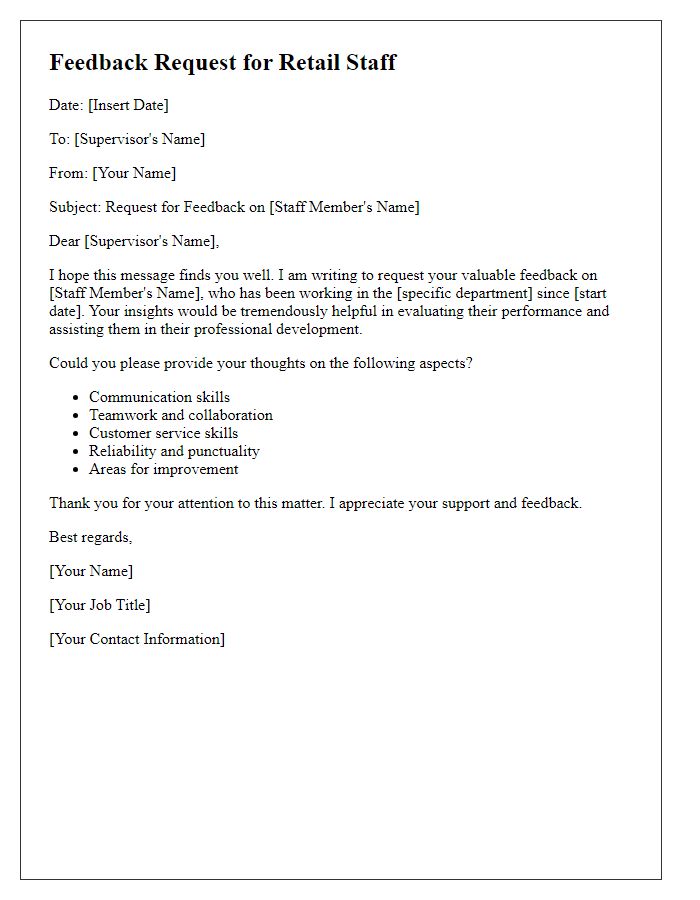Hey there! We all know how crucial feedback is in the retail world, especially when it comes to improving customer experiences and team dynamics. That's why we're reaching out to gather insights from our amazing retail staffâyour opinions matter more than you think! By sharing your thoughts, you can help us create an even better work environment and enhance our overall service. So, let's dive into how you can contributeâread on for more details!

Subject Line Optimization
Subject lines play a crucial role in capturing the attention of retail employees regarding feedback requests. Effective subject lines should be concise and engaging while clearly indicating the purpose. For example, "We Value Your Feedback: Help Us Improve Your Retail Experience!" emphasizes the importance of employee input and suggests a positive outcome. Another option, "Share Your Thoughts: Help Shape Our Retail Team's Future!" fosters a sense of inclusion and teamwork. Utilizing action-oriented verbs drives prompt responses, while personalization, like including the employee's name, can enhance engagement. Ultimately, a compelling subject line can significantly increase the likelihood of participation in feedback initiatives.
Clear Call-to-Action
Retail employee feedback surveys enable management to enhance operational efficiency and improve employee satisfaction. Participation rate can often directly impact the quality of collected insights. In stores like Macy's or Walmart, gathering feedback on aspects such as employee training, store layout, and customer service can identify areas for improvement. Specific metrics could include satisfaction ratings on a 1-10 scale or open-ended suggestions. Implementing a structured feedback system with clear deadlines can encourage timely responses, ensuring data is relevant and up-to-date. Engaging employees in this process, such as through one-on-one sessions or online platforms, fosters a culture of open communication and continuous improvement.
Personalization and Tone
Retail employee feedback is crucial for enhancing customer experiences in various retail environments, such as department stores or specialty shops. Personalization involves understanding individual customer preferences, such as favorite brands or preferred shopping frequencies, to create tailored recommendations. Tone plays a significant role in communication; friendly and approachable tones foster a welcoming atmosphere, encouraging customers to engage. For instance, utilizing casual greetings or warm language when addressing clients can build rapport, leading to increased customer loyalty. Feedback should focus on specific areas, such as product knowledge, service speed, and overall experience, to gather actionable insights for improving employee performance and satisfaction.
Incentive and Motivation
Retail employee feedback is crucial for fostering an engaged workforce. Motivational incentives, including performance bonuses and recognition programs, can lead to increased job satisfaction and productivity. Employee sentiments collected through surveys, such as the Gallup Q12, can provide actionable insights into workplace morale at locations like Target or Walmart. Understanding team dynamics within busy retail environments, particularly during peak seasons like Black Friday, can highlight the need for effective communication and support systems. Establishing a culture of feedback encourages employees at all levels to share their experiences, creating an atmosphere of trust and collaboration that can significantly impact overall retail performance.
Easy Feedback Process
Retail employee feedback plays a crucial role in enhancing operational efficiency and customer satisfaction. Implementing a user-friendly feedback process can significantly impact staff engagement. A simplified system involving concise online surveys or suggestion boxes can be effective. Regular feedback cycles, such as quarterly reviews or monthly check-ins, help gauge employee sentiments and gather actionable insights. Ensuring anonymity encourages honest responses, fostering a culture of open communication. In addition, sharing feedback outcomes with the team can enhance trust and motivate continuous improvement, ultimately benefiting the overall retail environment and customer experience.
Letter Template For Retail Employee Feedback Request Samples
Letter template of employee performance feedback request for retail staff.

Letter template of customer service feedback request for retail associates.

Letter template of performance review feedback request for retail workers.











Comments